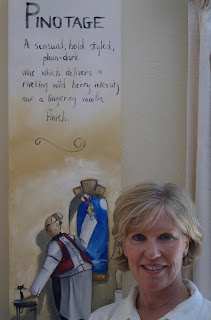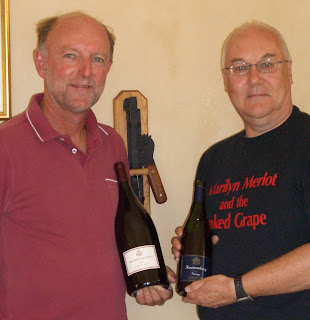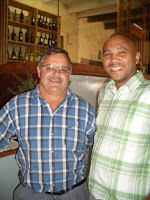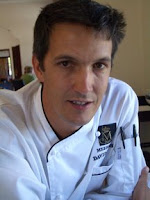 There's a lot of Pinotage activity on the web this week.
There's a lot of Pinotage activity on the web this week.On the elevated realms of Robert Parker's wine discussion forum, Port guru Roy Hersh likens aged Pinotage to southern Rhones. He has just opened a 1999 Beyerskloof Pinotage.
"It is not one of those ungodly wines that those who hate Pinotage would turn their nose up at. In fact, most people do not age their Pinotage ... unless they know any better. Having tried 20-30 year old examples (in country) I know that some ... can and do become beautiful old wines, but obviously there are not many that do.
At just 7-8 years old, this wine is showing beautifully and I'd say at about peak performance. It would still drink well 5+ years from now too, but I don't think it will ever be better than it is today. It is showing a dark crimson color with a clear edge and no signs of maturity in terms of its appearance. The nose is dapper, with a smoky and spicy scent initially but the subtlety wears off and it literally explodes with leather, pine resin and a plum earthiness that is gorgeous (if you like the style). It is closer to the aromatics of a So. Rhone wine than what most people think in terms of as So. African ... no less Pinotage.
On the palate it shows great viscosity and the heavy weight is as plush as a deep pile carpet. This is fun to roll around the mouth and we have half a bottle left to enjoy with our steak dinner in a few minutes. But already the prune, tobacco, meaty flavors and clay come to the fore. I don't normally use clay as a descriptor for a flavor profile ... but I think that those 4 ppl. on this BB, that enjoy aged Pinotage know the note I am describing. I have to take a look at the alc. % but there is no signs that this is out of synch. In fact the delicious fruit and acidity are singing already and this was not even decanted!"
Another person in love with Beyerskloof is an anonymous lady who blogs under the name 'Classy Rump', although I wonder what her unlucky husband thinks. She sent him out to the farmers market to buy a shoulder of lamb which she slow cooked in Port. She says "Drank Beyerskloof pinotage, one of my absolute faves, - went perfectly with the spicy lamb. Lovley. Had intended giving Hubs one of my special BJs to cheer him up but crashed out and woke up side by side on the sofa hours later like a pair of tinned sardines."

And on the UK wine forum, Richard Ward tried Charles Back's Pinotage-Viognier, 2005, Paarl, 14.5% on a Tesco supermarket half price offer -
"F*** me - this tastes exactly like Musar!! A eureka moment - a pinotage I actually like, with a velvetty texture and mouthfeel, soft earthy aromas and (surprisingly given the 14.5% alcohol) no astringency on the finish. I don't know if it's the addition of 4% Viognier which has helped it, or if it's just really well made, but this is superb. No jamminess, no medicinal notes, no beefy/smokey flavours - just a really deep yet soft and well rounded wine. Tasted blind I would have sworn it was Musar. I was literally blown away by this wine - I've never tasted a pinotage like it. 91pts."
And, ahem, (well there are Pinotage wines featured in it), over at wine.co.za Neil Pendock gave an enthusiastic review of my book Marilyn Merlot and the Naked Grape" and says "Wine pundit for the Observer, Tim Atkin may list “never trust a person who collects wine labels” in his enumeration of the Top 25 Wine Truths, but in the case of Peter May I’m prepared to make an exception. He’s been a judge on the ABSA Top Ten Pinotage Competition and so must be as squeaky clean as a Stelvin screwcap. And on the basis of this collection of wine oddities, even screwier."
No Comment :)



























